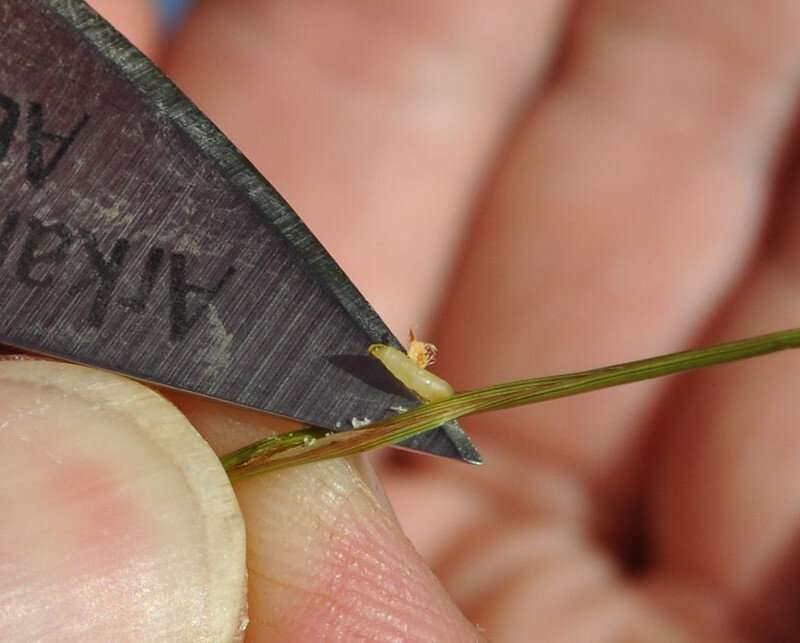New research helps hay producers manage Bermuda grass stem maggot

A relatively new pest—the Bermuda grass stem maggot—is plaguing Texas hay producers this season, according to Texas A&M AgriLife Extension Service experts.
However, new research from Texas A&M AgriLife is helping growers better manage this pest.
"Previously, there was no information on how damaging this insect was to hay production and thus no guidelines on when an insecticide was needed to protect yields," said Dr. Allen Knutson, AgriLife Extension entomologist, Dallas. "Our field research documented that for each percentage of stems with stem maggot damage, there is a potential loss of 8.9 pounds of hay per acre."
Using data from fields in North Texas, Knutson and Dr. Forrest Mitchell, Texas A&M AgriLife Research entomologist, Stephenville, developed guidelines as to when an insecticide treatment is justified based on the cost of treatment and value of hay.
Dr. Vanessa Corriher-Olson, AgriLife Extension forage specialist, Overton, said she has received numerous phone calls and emails from producers and reports from AgriLife Extension agents in the region regarding the pest. She has also found them in hay and forage pastures at the Texas A&M AgriLife Research and Extension Center at Overton.
There was very little Bermuda grass stem maggot activity reported in the state last season, she said, but this appears to be a banner year for the pest.
"They're definitely out there," she said. "A few weeks ago, we had reports from Central Texas, but it's not just there anymore. We can assume that if you have Bermuda grass in the state of Texas, you should be watching for signs of stem maggots."
Feeding by the stem maggot causes the death of the top two to three leaves while the rest of the plant remains green. This gives a stand of Bermuda grass the appearance of frost damage. Also, the discolored top leaves are easily pulled from the leaf sheath, and plant growth is stunted.
"They're typically not a major problem in grazing pastures because cattle are grazing those top leaves," she said. "But they can cause serious damage in a hay meadow. The field will look like it's been burned by frost, and stem maggot damage is often confused with a chemical burn."
To use the new guidelines, it is necessary to estimate the level of stem maggot damage. To do this, Knutson advises cutting a handful of grass at the base of the stems and carefully examining 50 stems at random for stem maggot damage. Set aside those with the top two leaves dead and easily pulled from the sheath. Once 50 stems are examined, calculate the percent of damaged stems in the sample. Repeat this at five to 10 locations across the field and calculate the average percent of damaged stems for the field.
The new guidelines consider the cost of insecticide and the value of hay in determining when insecticide treatment is economically justified, Knutson said.
"For example, if the insecticide application cost is $12 per acre and the hay value is $140 per ton, the treatment threshold is 16% of the stems with stem maggot damage," he said. "If the average field infestation is 16% or greater, an insecticide treatment should result in a positive economic return. If the control cost is $12 an acre, and hay value is $100 per ton, then the treatment threshold is 22% or more of the stems with stem maggot damage."
In fields where stem maggot damage is already extensive, an insecticide treatment may not be sufficient to get the crop growing again, Knutson said, because damaged stems shade the lower nodes, preventing regrowth of new shoots. In this situation, the hay should be cut and removed as soon as possible to allow sunlight to stimulate regrowth.
A pyrethroid insecticide should be applied seven to 10 days after cutting to protect the regrowth from another stem maggot infestation.
"Weekly field inspection to determine the percent of stems with maggot damage can reduce the risk of significant yield loss and determine if and when insecticide treatment is justified," Knutson said.
The Bermuda grass stem maggot is an invasive pest native to southern Asia and was first reported in Georgia in 2010. The pest has been found in Texas since 2012.
This pest only infests Bermuda grass and stargrass, Corriher-Olson said. The fly, which is yellow with a black head, lays its eggs inside the Bermuda grass stem. After the egg hatches, the larva, or maggot, which is white with a black head and 1/8th to 3/16ths inch long, moves to the last plant node and begins consuming the plant material within the stem.
More information: Guidelines on managing Bermuda grass stem maggot and the table of treatment thresholds for a range of control costs and hay values are available online at foragefax.tamu.edu/.
Provided by Texas A&M University




















